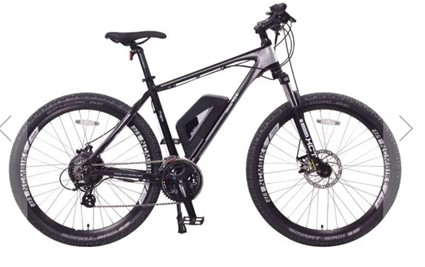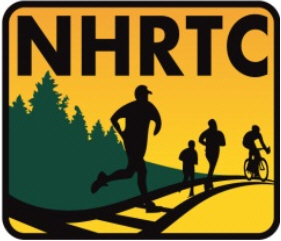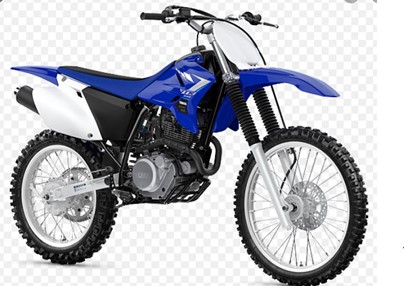What is the difference between a motorized trail bike and an electric mountain bike?
We have found the distinction is confusing many people. In particular, people want to know which kinds of bicycles with motors are permitted to use rail trails.
Off-Highway Recreational Vehicles (OHRVs)
The “OHRV” term applies to both All-Terrain Vehicles (ATVs) and small motorcycles designed for off-road use. Manufacturers sometimes distinguish between ATVs and Utility Terrain Vehicles (UTVs), where UTVs allow two people to set side-by side. We use the ATV term to encompass both narrow and side-by-side versions.
Motorized Trail Bikes look like this:
They have powerful engines and excellent maneuverability. Riders like to go places where the surface is rough going. Crossing shallow ponds and rivers is easy for them. They are propelled solely by the motor, not by pedaling, and are often called “dirt bikes.”
Electric bikes (e-bikes)
Electric bikes look like this:

They usually have a mechanism for shifting gears, a small motor (often in the rear hub), and a fairly small battery. Older bicyclists appreciate having the boost they provide, especially going up hills.
Some e-bikes, like the one pictured above, are made for rougher surfaces. Often termed “e-mountain bikes” (e-MTBs), they have a strong frame and fatter tires. Others have more of a touring frame and somewhat narrower tires. All have pedals, as the motor is designed to assist, rather than replace pedaling.
e-bike classifications
The bike community classifies e-bikes into three classes, defined loosely as:
Class 1: Pedal-assist only, with no throttle. The maximum assisted speed is 20 mph.
Class 2: Throttle-assisted with a maximum speed of 20 mph.
Class 3: Pedal assist only with no throttle. The motor stops assisting at 28 mph. A speedometer is required.
All three of these classes of e-bikes are called “Low-Speed Electric Bicycles” (LSEBs) with a motor not exceeding one horsepower or 750 watts. Almost all LSEBs have motors in the range of 250-350 watts, about the same power a “human engine” applies to the pedals.
Bikes with electric motors that can go beyond 28 mph or have motors exceeding one horsepower are called “Out of Class Electric Vehicles (OCEVs). They are considered to be OHRVs by the industry, but without operator license or registration requirements in most states.
Can e-bikes ride on rail trails in New Hampshire?
In general, Class 1 and Class 2 e-bikes are allowed on New Hampshire rail trails wherever bicycles are permitted. This is similar to the treatment of other “mobility devices” needed by people with physical handicaps. Class 3 e-bikes are not allowed on New Hampshire rail trails per state law.
Note that 20 mph is a rapid speed. Few bicycle riders who are not racers can keep up that speed for long. Most e-bike riders will travel at a speed of 12 mph or less.
What is a “trail bike?”
Technology advances are making the term “trail bike” unhelpful. Bicycle manufacturers refer to fatter tire bikes with or without electric motor assist, often with full suspension, as “trail bikes.” Motorcycle manufacturers refer to their machines as “trail bikes” if they support travel over rugged terrain.
Watch out for this slippery terminology!
September 6, 2020 Charles Martin

